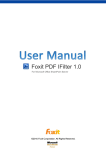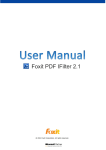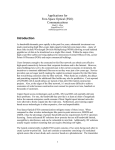Download Betaspec 2.0 User Manual - University of South Florida
Transcript
User Manual Program to generate atmospheric backscatter and attenuation coefficients using BACKSCAT 4.0 / LOWTRAN 7 aerosol models. Betaspec Version 2.0 (released September 10. 2009) Distributed by: Ontar Corporation 9 Village Way North Andover, MA 01845-2000 Phone: 978-689-9622 Fax: 978-681-4585 Email: [email protected] Web site: http://www.ontar.com Technical information: Prof. Dennis Killinger Denis V. Plutov (Pliutau) University of South Florida Tampa, FL, 33620 Phone: 813-974-3995 Email: [email protected] Web site: http://www.cas.usf.edu/lidarlab/ Copyright 2009 University of South Florida Table of contents 1 Overview of the Betaspec 2.0 program........................................................................... 3 1.1 Installation and user manuals for Betaspec and BACKSCAT..................................... 4 1.2 Important installation information to avoid problems with Windows Vista ............... 8 1.3 Betaspec 2.0 interface overview .................................................................................. 10 2 Main menu options of the Betaspec 2.0 program ........................................................... 14 2.1 Run menu ..................................................................................................................... 14 2.2 Config. files menu........................................................................................................ 14 2.3 Plot menu ..................................................................................................................... 16 2.4 Wavelengths menu ....................................................................................................... 20 2.5 Aerosols ....................................................................................................................... 20 2.6 Atmosphere .................................................................................................................. 21 2.7 File ............................................................................................................................... 21 2.8 Quit .............................................................................................................................. 22 3 Program files ................................................................................................................... 23 3.1 Listing of files in the Betaspec 2.0 directory ............................................................... 23 3.2 Interaction of the Betaspec program with the BACKSCAT program ......................... 23 4 Development history of Betaspec ................................................................................... 24 2 1 Overview of the Betaspec 2.0 program The Betaspec program has been created in order to provide a user friendly interface for generating atmospheric attenuation (α, km-1) and backscatter (β, sr-1 · m-1) coefficients due to the presence of aerosols and molecular Rayleigh scatter by means of running the AFGL / Sparta BACKSCAT 4.0 program over a range of wavelengths in the 0.2 – 40 micron spectral range. Betaspec 2.0 is a user friendly version of the US Air Force BACKSCAT (Version 4.0) program which is a Microsoft Windows based computer program that users the LOWTRAN 7/FASCODE aerosol models). The BACKSCAT program is a Lidar simulation program that determines the lidar S/N ratio for a wide range of targets and systems. As part of this simulation, the BACKSCAT program calculates the appropriate aerosol and Rayleigh attenuation and backscatter coefficients for a wide range of atmospheric conditions including a US Standard Atmosphere, clouds, haze, fog, rain, etc. The Betaspec 2.0 program uses the main aerosol attenuation/backscatter kernel of the BACKSCAT program, but adds a user friendly interface to allow the user to easily change the weather conditions and wavelength range of the calculations. The output from the BETASPEC program is a data array of the backscatter coefficients and aerosol attenuation coefficients as a function of wavelength and of altitude. The output file (*.BASC or *.ASC file extensions), contains the attenuation and backscatter coefficients due to aerosols (clouds, dust, etc.) in the atmosphere. It should be noted that the Betaspec program calculates the attenuation due to aerosols and Rayleigh scatter in the atmosphere. Such values are valid for non-resonant transmission through the atmosphere when the optical or laser wavelength is not on a resonant absorption line of molecules in the atmosphere. The HITRAN-PC program calculates the additional attenuation due to resonant absorption of molecular lines in the atmosphere, which can then be added to the attenuation due to aerosols and Rayleigh scatter for the total attenuation. 3 1.1 Installation and user manuals for Betaspec and BACKSCAT This section will explain a typical Betaspec 2.0 program installation procedure. The examples in this section are for Windows Vista operating system, but Windows XP will result in very similar installation sequence. Betaspec 2.0 is stored under the C: Hard Drive in the Betaspec 2.0 subdirectory. Note: if the user has already installed Betaspec 2.0 on his computer, and wants to re-install it, then the user should delete the previous Betaspec 2.0 program first, by going to the Start >> Control Panel >> Add/Delete Programs, and then reinstall the Betaspec 2.0 program. The following gives details of the files contained on the Betaspec CD disk, and the installation procedure for installing Betaspec on your computer. Files contained on Betaspec 2.0 Installation CD: The listing of the files on the Betaspec 2.0 installation CD is presented below: Autorun.inf – File used to automatically load the setup.exe file when the CD is loaded BACKSCAT 4.0 Manual.pdf – Manual for the BACKSCAT 4.0 program betaspec.ico – Betaspec icon file (used to display the icon for the CD drive) Betaspec 2.0 Manual.pdf – Manual for Betaspec 2.0 Betaspec 2.0 serial number.txt – File with unique serial number (also in Betaspec 2.0.exe) Betaspec 2.0 Setup.msi – Compressed library file containing the contents of the installation package setup.exe – Executable file used to install the Betaspec 2.0 program Note: The BACKSCAT program has a Technical Report / Manual associated with it, which is available free of charge at the following web site http://handle.dtic.mil/100.2/ADA285851. This manual is also supplied with the Betaspec program and loaded onto the user's computer (file BACKSCAT 4.0 Manual.pdf mentioned above). The installation of Betaspec 2.0 is as follows: 1) Insert the Betaspec 2.0 CD into the CD-ROM drive of your computer, the windows operating system will ask you if you would like to “Run setup.exe” or “Open folder to view files”, as shown in the figure below. Choose “Run setup.exe” to start the installation. 4 It is desirable that your computer is connected to the internet at the installation time in case the NET 2.0 Microsoft library required for Betaspec operation is not installed on your computer. In this case the installation program will try to automatically install the missing NET 2.0 component from the Microsoft website before installing the Betaspec program. This may take about 15 minutes to download the NET 2.0 library. 2) At a certain point during the installation process Windows may ask for your permission to run the installation program, choose “Allow” to run the installation file. 3) Wait for the windows installer to prepare the installation 4) In the next window start the installation by pressing “Next”. 5 5) Choose a directory to install the Betaspec 2.0 program to. The default directory is: C: >> Betaspec 2.0 The C:>> Betaspec 2.0 directory is used to avoid operational problems with Vista operating system (discussed later). If multiple accounts are used on your computer, it is also possible to choose if the program should be installed for the current user only or all users on this computer. 6) In the next window confirm the installation by pressing “Next” 6 7) Wait for the program to install 8) Once the installation is complete the confirmation window will appear, choose “Close” to close the installation program. 7 9) The Betaspec 2.0 installation program will place a shortcut icon to the Betaspec 2.0 executable on the Desktop: In addition to the icon created on the desktop for the Betaspec 2.0 program, the installation program will create a folder in the Windows start programs menu as shown below This folder will contain a link to the Betaspec 2.0 executable program, Betaspec 2.0 user manual and BACKSCAT 4.0 user manual in PDF format. Note: If the Microsoft NET 2.0 framework is not installed on your computer, the Betaspec 2.0 installation program will attempt to download and install the required .NET framework component from the Microsoft website automatically before installing the Betaspec program. Installing the .NET framework component may take around 15 minutes and should only be carried out once. Uninstalling the Betaspec 2.0 program later will not remove the .NET 2.0 framework component from your computer since this Microsoft library will probably be used by other programs. 1.2 Important installation information to avoid problems with Windows Vista: Installation of Betaspec in Root directory as opposed to Program Files directory This section explains some Betaspec 2.0 installation problems which have been found under the Windows Vista operating system if the normal procedure to install the executable Betaspec 2.0 program is followed and the program is installed in the C:>> Programs Files directory, and how to avoid them. Betaspec 2.0 program requires write permissions for some of the files located in the Betaspec 2.0 installation directory to operate properly. However, due to the introduction of the User Account Control (UAC) feature in Windows Vista (as opposed to XP), creation of new files and folders as well as modification of files which already exist in the Programs Files directory requires administrative privileges. It would be wrong to assume that all users of Betaspec program will have such administrative privileges and if the Betaspec 2.0 program is installed within the Programs Files directory under the Windows Vista operating system, the following 8 problems are very likely to occur (unless the User Account Control feature is turned off or the Betaspec program is executed in administrative mode): 1) When the Betaspec program is operated, it requires write access to several files in the Betaspec 2.0 program folder for correct operation. Such files include the default configuration files (betaspec.bcfg), initialization file (betaspec.start), and some of the BACKSCAT 4 model files. Unfortunately, due to the UAC feature and/or non-administrative mode, Windows Vista will not let the Betaspec program write into these files directly but rather make a copy of the files in a special virtual folder and use the duplicate files instead of the actual files located in the Programs Files directory. The location of such virtual folder is as follows: C: >> Users >> Your user name >> AppData >> Local >> VirtualStore >> Program Files >> Betaspec 2.0 directory … Where Your user name is the current user name under the Windows operating system. 2) Duplicate files are created for all files located in the actual Program Files directory that the Betaspec program tries to write into. After such duplicate files have been created, the Windows operating system will access them first before reading the files located in the actual Program Files directory. This redirection process will result in that every time a file in the Programs Files directory is modified by the user, the modification will be applied to the duplicate of that file stored in the Virtual Store directory as described above and the files in the Programs Files directory remain unmodified. This process is carried out automatically by the Windows operating system with no notification to the user. 3) Such virtual files are not removed automatically by the Windows Operating system during the un-installation process and have to be manually deleted. As such, in order to avoid the problems described above, it is highly recommended to NEVER install the Betaspec 2.0 program into the Program Files directory under Windows Vista. 9 1.3 Betaspec 2.0 interface overview 1.3.1 General interface overview The main form of the new Betaspec program is presented below. It consists of the Plot area and the Auxiliary panel, as shown below. Auxiliary panel Plot area The Auxiliary panel contains the Results list and the Plot controls, as shown below. Plot controls Results list 10 Plot controls contain the Plot value and Plot component sections, as shown below. Plot value section specifies if the Alpha (α, km-1) or Beta value (β, sr-1 · m-1) should be displayed in the Plot area as well as the Results list. Plot component section indicates which component of either Alpha or Beta value specified in the Plot value section should be displayed on the plot. Once any of the Plot Controls options are modified, the maximum and minimum values are recalculated (unless specified otherwise with the Plot>>Automatically rescale vertical axis option) and the plot is modified accordingly to display the chosen Alpha or Beta component. The Results list is only updated when switching between Alpha and Beta Plot value options is done. Plot value section is identical to Plot >> Plot value option form the main menu. Plot component is identical to the Plot >> Plot component section from the main menu. The results list is shown below. It is used to display the numerical results (Alpha or Beta values depending on the Plot value option selected) from the last calculation as well as for viewing different slices of the 3D plot as described in later. 11 1.3.2 Viewing slices After a calculation is complete the results of the calculation are displayed in the Results list of the Auxiliary panel and the user has the option of viewing the 3D cumulative plot or switching to a 2D plot view with the possibility of displaying different slices (either Wavelength or Altitude slices) by means of the procedure outlined in this section. After the calculation is complete and the 2D mode is chosen (by unchecking the Plot>>3D Plot option in the menu), the user may view Altitude or wavelength slices by selecting a particular line in the Results list (using a mouse or the Up and Down keys). Depending on the slice type (values in the list are a function of Wavelength or Altitude) the plot will be displayed as a function of either wavelength or altitude. For example, in the screen shown below a range slice at 4.0 km (4.0 km line is selected) is displayed in the plot as a function of wavelength. Please note that the numerical values displayed in the list do not correspond to the currently selected slice at any particular moment. Only the Altitude or Wavelength values in the list are used for the Plot slice selections. The actual numerical values in the list correspond to the slice type displayed under the Slice type (Wavelength / Altitude) and the Slice at (micron / km) value as circled in the figure above. In order to choose which slice the numerical values in the list are to be displayed for, it is necessary to double click on a particular item in the list. For example, if the user would like to view the numerical values for the altitude slice (slice along the altitude axis) at 4.0 km, it is necessary to double click on the item in the list corresponding to the 4.0 km Altitude value. After that 4.0 km Altitude slice values will be displayed, as shown in the figure below and the Plot will display wavelength slices at a particular wavelength corresponding to the wavelength 12 currently selected in the list. Thus any plot slice currently displayed does not correspond to the Alpha or Beta values currently displayed in the Results list (only the Wavelength or Altitude values in the results list do). It is worth pointing out that the auxiliary panel may be hidden to maximize the plot area by pressing the >> button as shown in the figure above. Once that button is pressed, the << button may be pressed to return to the Auxiliary panel. 13 2 Main menu options of the Betaspec 2.0 program 2.1 Run menu Choosing this option from the main menu will run the BACKSCAT calculation for the spectral range specified using the Wavelengths option, the chosen Aerosol type and the atmospheric model used. 2.2 Config. files menu This menu option allows loading and saving the Betaspec program configuration (calculation parameters only). 2.2.1 Reload parameters from default BETASPEC.BCFG file Choosing this option will reload the configuration parameters from the default configuration file stored in the Betaspec program directory. 2.2.2 Save current parameters to default BETASPEC.BCFG file Choosing this allows saving the configuration parameters to the default configuration file stored in the Betaspec program directory. 2.2.3 Load parameters from *.BCFG type file This allows loading the current configuration from an arbitrary file specified by the user. 2.2.4 Save current parameters to *.BCFG type file This option allows saving the current configuration to an arbitrary file specified by the user. 14 2.2.5 About Betaspec This option allows viewing information about the Betaspec program developers. 15 2.3 Plot menu This section describes the options available in the Plot menu. 2.3.1 3D Plot This option is used to switch between the 3D plot and 2D plot slices at particular wavelengths or ranges. 2.3.2 Plot value This allows specifying if the Alpha (α, km-1) or Beta (β, sr-1 · m-1) value is to be displayed in the plot. 2.3.3 Plot component 16 This option indicates which component of either Alpha or Beta value is to be displayed in the plot (Total, Rayleigh or Mie). The last option “Aerosol / Mie absorption” is only available if the Plot value is set to Alpha. 2.3.4 Vertical axis parameters Choosing this will result in a new window to open which will allow changing some parameters related to the vertical axis setup. The window is shown below. This window allows modification of the maximum and minimum values along the vertical axis as well as the value to be used instead of zero in the logarithmic mode. It is also possible to specify the plot value (Alpha or Beta), plot component (Total, Rayleigh or Mie) as well as the type of plot (Linear or Logarithmic). If the graph minimum or maximum is manually modified, the automatically rescale vertical axis option is disabled (see “Automatically rescale vertical axis” option below). 2.3.5 Vertical axis logarithmic scale This option indicates if the scale along the vertical axis should be logarithmic or linear 2.3.6 Range axis logarithmic scale This indicates if the horizontal axis should be linear or logarithmic. 17 2.3.7 Show graph cursor This option indicates if the graph cursor should be shown on the plot (to display the current position of the mouse). 2.3.8 Show overlay grid This indicates if the overlay grid should be shown. 2.3.9 Plot in black and white By default the 3D plot is displayed as a colored mesh, the color representing the magnitude along the vertical axis. Plot in black and white option makes it possible to display the mesh in black and white instead of using the color. 2.3.10 Plot type This indicates if the datapoints on the plot should be displayed as lines, points, lines and points or as a bar graph (only applicable to the 2D plots). 2.3.11 Automatically rescale vertical axis If this option is selected, the vertical axis should be rescaled automatically after either Plot value or Plot component option is changed. This is done by scanning the entire data to find the largest and the smallest value along the vertical axis (Alpha or Beta; Total, Rayleigh or Mie component). 2.3.12 3D plot resize mode This option specifies how the 3D plot should be resized at rotation. 18 2.3.13 Change mesh density If this option is chosen, the window shown below will appear which allows changing the density of the surface mesh in the 3D plot mode. 2.3.14 Show front box frames This allows displaying the front frames (of the axes frame) of the coordinate system. 19 2.4 Wavelengths menu Once the Wavelength option in the main menu is selected the window shown below will open. It allows specifying the starting and ending wavelength (in the 0.2 – 40 micron range) as well as the number of equidistant wavelengths to use in the region specified. 2.5 Aerosols This window allows specifying the aerosol characteristics to be used in the next calculation. 20 2.6 Atmosphere This option in the main menu allows changing the atmospheric model to be used in the next calculation. 2.7 File File menu allows saving the results of the calculations. 2.7.1 Save Alpha / Beta values to *.BASC text file… This allows saving the results of the calculations to a *.BASC file. The difference between the old *.ASC file format and *.BASC is the use of the Tab symbol in the *.BASC file as a delimiter as opposed to multiple spaces in the previous format. The new extension has also been introduced to avoid confusion between the ASCII files generated with the Hitran-PC program to use with Lidar-PC with the ones generated by the Betaspec since they have different data formats and contain different physical values. The new Lidar-PC program (Version 3.0) will be capable of reading the both the new *.BASC and old *.ASC files generated with the Betaspec 1.0 program. Please note that the use of the binary files *.BIN has been completely abandoned in the new versions of the Betaspec and the next version of the Lidar-PC programs. 2.7.2 Save current slice values to *.TXT text file… This option allows saving the calculation results for the currently displayed slice (Wavelength or Altitude slice). Even though Alpha and Beta values are not displayed at the 21 same time in the calculation results list, all values (both Alpha and Beta are saved to the text file with the slice values). 2.7.3 Save Alpha / Beta values to *.ASC (old format) text file By selecting this option the user is able to save the calculation results in the old Betaspec 1.0 format (*.ASC) format. This option was kept for compatibility with the Lidar-PC 2.0 program. 2.8 Quit Click Quit to exit Betaspec 2.0. 22 3 Program Files 3.1 Listing of files in the Betaspec 2.0 directory The listing of files and folders in the Betaspec 2.0 folder after the installation is presented below: backscat4 – directory with BACKSCAT 4.0 program files. BACKSCAT 4.0 Manual.pdf – Manual for BACKSCAT 4.0 program in a PDF form betaspec.bcfg – Betaspec configuration file containing the calculation parameters betaspec.start – Flag file indicating how the splash screen should be displayed Betaspec 2.0 Manual.pdf – Manual for the Betaspec 2.0 program Betaspec 2.0.exe – Betaspec 2.0 program executable file pdficon.pfd – PDF icon file used for correct display of PDF files in the startup menu. 3.2 Interaction of the Betaspec program with the BACKSCAT program Some of the BACKSCAT program files supplied with the Betaspec program have names different from the ones given in the BACKSCAT manual. The Betaspec operates by writing simulation parameters into text files which are used by the BACKSCAT program (b4.exe file) to produce output aerosols attenuation and backscatter data. The output data is read in by the Betaspec program for user-friendly representation. The Betaspec program writes the wavelength of the simulation into the TEMP.LDR file (corresponds to the bscatv4.ldr file in the BACKSCAT manual), and by writing atmospheric parameters into the TEMP.CFG and DEFAULT.ATM files (these files correspond to bscatv4.cfg and bscat4v.atm in the BACKSCAT manual). The results of the simulation are stored in the DEFAULT.PFL file (corresponds to bscatv4.pfl in the BACKSCAT manual). Betaspec executes BACKSCAT 4.0 program as many times as there are wavelengths to obtain a map of aerosols attenuation and backscatter coefficients as a function of wavelength and altitude. 23 4 Development history of Betaspec The previous Version 1.0 of the Betaspec program has was developed by Dr William Wilcox Jr. and Prof. Dennis K. Killinger. Since version 1.0 of the Betaspec program was originally designed to work with the Microsoft DOS operating system is has several known compatibility issues with Windows XP and fails to work with Windows Vista. Version 2.0 of the Betaspec program is a new version which has been developed by Prof. Dennis Killinger and Denis Plutov (Pliutau) to operate under Windows XP and Vista using the .NET Framework 2.0. 24































